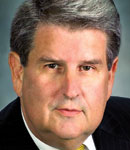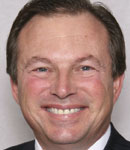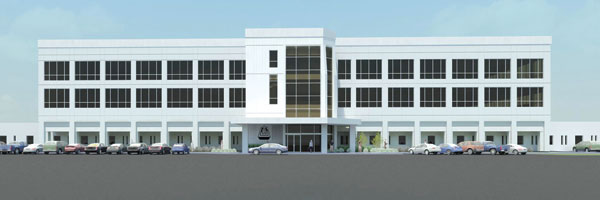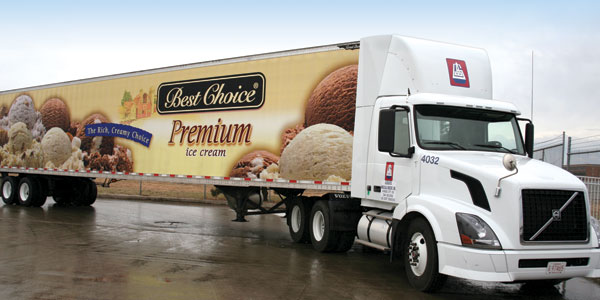Associated Wholesale Grocers may be on the verge of shaking up the retail business in the Deep South as it prepares to open a new Gulf Coast distribution center there early next year.
 “We think the potential for additional volume is tremendous,” Jerry Garland (right), president and chief executive officer of the Kansas City, Kan.-based member-owned cooperative, told SN.
“We think the potential for additional volume is tremendous,” Jerry Garland (right), president and chief executive officer of the Kansas City, Kan.-based member-owned cooperative, told SN.
In its annual report, the company said the Gulf of Mexico region “was identified as having the highest potential growth for AWG.”
The facility will be located in Pearl River, La., approximately 40 miles north of New Orleans. It will service customers in what will become the wholesaler’s new Gulf Coast division, which will stretch from Tallahassee, Fla., to Houston, Texas, encompassing customers in Alabama, Florida, Georgia, Louisiana, Mississippi and Texas.
One of the primary reasons for opening a warehouse in Louisiana is to ease the strain on the company’s distribution center in Memphis, Tenn., “where we’ve been stretched over the past two years and where we’re close to maximum capacity,” Garland explained.
Operating a warehouse to service stores in the Gulf region “will save [those] retailers more than $6 million annually in freight costs,” Garland noted. “It will lower our transportation expenses and improve the availability of affordable fresh food offerings and locally harvested products to consumers along the Gulf Coast.”
Approximately 150 stores will transfer to Pearl River, most from the Memphis warehouse, Garland noted.
AWG already has a sales base of over $500 million in the region, Garland noted — having served customers there since 2003, when it acquired a distribution center in Memphis from Fleming Cos., and getting another boost in 2009 when it picked up $350 million in sales after Affiliated Foods Southwest, Little Rock, Ark., went out of business.
 The Pearl River warehouse will be capable of handling between $1 billion and $2 billion worth of business, Jeff Reasor (left), chairman and CEO of Reasor’s Markets, Tahlequah, Okla., and an AWG director, told SN. “It’s being built big enough to handle that kind of volume.”
The Pearl River warehouse will be capable of handling between $1 billion and $2 billion worth of business, Jeff Reasor (left), chairman and CEO of Reasor’s Markets, Tahlequah, Okla., and an AWG director, told SN. “It’s being built big enough to handle that kind of volume.”
He said he believes AWG is in a good position to acquire some business from companies in the region willing to look at alternative sources of supply.
“A lot of retailers in different parts of the country talk to each other about different warehouses, and there are companies in the Gulf region trying to find their way,” Reasor said. “AWG has already talked to some folks in the Gulf region, and others — both large and small — have been coming up to Kansas City, though none has made a firm commitment yet.”
Chuck Murfin, owner of four Murfin’s Markets in Missouri and an AWG director, told SN the Gulf Coast “offers us a large retail base,” and he said it’s likely the wholesaler will pick off some retailers currently served by other wholesalers.
“We bring a lot to the table,” he said. “AWG’s biggest strength is being a cooperative. Many independents are leaving a lot of money on the table by not being part of a co-op, and as many former customers of Affiliated Foods and Fleming have discovered since they joined AWG, their bottom lines have improved.”
Roger Collins, chairman and CEO of Harps Food Stores, Springdale, Ark., and an AWG director, said the company “hopes the new Gulf region will be valuable. It all depends on our ability to fill the warehouse.
“Our goal is trying to figure out how to get the warehouse operating at full capacity to keep overhead costs down. That’s why we’re making the investment there.”
Good News for Retailers
As it enters the Gulf region, AWG will be competing for business with three other major wholesalers: Supervalu, Minneapolis, and C&S Wholesale Grocers, Keene, N.H., both voluntaries; and Associated Grocers, Baton Rouge, La., a cooperative.
“The region is over-populated with wholesalers now,” an industry observer told SN, “and there’s a lot of money and other incentives flying around to encourage retailers down there to make some changes. As a result I suspect many retailers are having a lot of fun, especially in these tough economic times.”
According to another observer, AWG’s entry into an area with a large number of independents means the area is likely to become more competitive.
“AWG must think there are some great opportunities there if it’s making that kind of investment,” he pointed out, “and that means all the wholesalers operating there will have to become more competitive to hold onto their existing market share, and that’s got to be good for the retailers.
“That’s not to say the wholesalers doing business in the Gulf area are not serving their customers well — because I think they are doing a good job — but AWG is going to be looking for customers to boost the capacity of its new warehouse.”
AWG plans to locate the 720,000-square-foot Pearl River distribution center on a 68-acre site at the intersection of three major highways. It will be the company’s seventh grocery warehouse and its first new facility since it opened one in Oklahoma City in 2008.
Given its proximity to the Gulf of Mexico, the center has been designed to withstand extreme weather conditions and includes two high-capacity generators “to ensure continued operation throughout any event,” according to the annual report.
AWG has 620 members in 23 states operating slightly more than 2,800 stores that are supplied by six grocery distribution centers and two nonfood/specialty facilities.
Its distribution area for groceries extends north to Nebraska, Iowa and Illinois (with some nonfood distribution in Michigan), south to Texas, west to New Mexico and east to north Florida and Georgia.
Asked whether the company contemplates growth outside its current borders, Garland said, “Our growth strategy requires us to build the volume before we build a distribution center. Consequently our new member growth will come from areas contiguous to our current trade areas.”
Growth Strategies
AWG’s sales rose 7.3% last year to an all-time high of $7.8 billion, making it the nation’s second largest wholesaler behind Wakefern Food Corp., Keasbey, N.J. Garland said he expects sales to increase this year between 2% and 3%.
While some of the anticipated sales increases are likely to come from the new Gulf Coast region, observers said the company also sees growth opportunities in areas served by its Memphis, Nashville and Fort Worth warehouses.
Looking for growth has been a big part of AWG’s focus since Garland became president and CEO in 2009, one observer told SN. “He’s really propelled the company forward. He’s a very aggressive leader, and he certainly has been active in growing the company.”
Collins said Garland is continuing “to try to find ways to do things better. He doesn’t just sit back and say what we did before will be good for the future. He’s working hard to figure out how to make things better as times change.”
According to Murfin, “Looking at our growth over the last 15 years and where we came from, AWG has exceeded the expectations a lot of other wholesalers once had. So we must be doing something right to get those kinds of numbers.”
Garland said AWG is guided by a simple maxim — to help its member retailers to profit and grow.
“Any growth we experience has to meet a purpose,” Garland told SN. “As a cooperative our real purpose for existing is to have profitable, growing members. At AWG we know the cash register is still in the stores.”
Garland said he sees a bright future for AWG’s independent members. “Working together, we can be much more than any of us can be individually.
“As a cooperative, we have one sales plan and one cost file and remain transparent in our member dealings. That transparency breeds trust, which we believe is the most important element in the relationship between AWG and its retailers.
“There are many variations of the cooperative model in grocery distribution. Ours balances the cost effectiveness of size with the substantial cash-flow requirements of running a retail operation.”
AWG is firmly committed to the financial health of its members, “who reflect the future financial health of the cooperative,” Garland explained. “We continue to add between 600,000 square feet and 1 million square feet of retail space per year through expansions, new stores and new members. In the next two years we anticipate that rate will pick up.”
 Besides growing its distribution operations, AWG is growing its main office by expanding the facility to bring technology, store engineering, decor and design services, and nonfood administration — which have been operated in separate buildings — under one roof (see rendering above). It will mark the first time since 1992 that all corporate employees will be in the same building.
Besides growing its distribution operations, AWG is growing its main office by expanding the facility to bring technology, store engineering, decor and design services, and nonfood administration — which have been operated in separate buildings — under one roof (see rendering above). It will mark the first time since 1992 that all corporate employees will be in the same building.
The expansion, a 28,000-square-foot addition on the east side of the existing office facility, is expected to be operational by November.
AWG operates eight distribution centers: six grocery facilities — its two original warehouses in Kansas City (1 million square feet) and Springfield, Mo. (750,000 square feet), along with locations in Oklahoma City (800,000 square feet), Fort Worth (1.1 million square feet), Memphis (750,000 square feet) and Nashville (750,000 square feet) — and two nonfood facilities: general merchandise and specialty in Memphis (550,000 square feet) and HBC in Fort Scott, Kan. (225,000 square feet).
At the warehouse level it has added tracking systems and voice-activated picking systems over the last couple of years, “and we have exceeded our expected returns from technology,” Garland said. “Today our centers are more productive and more efficient than ever on less direct supervision.
“In addition, we have been able to add incentive programs to all facilities, which provide a great return for our members and more pay for our employees.”
AWG has doubled its volume since 2000, due in large part to the misfortunes of other companies. It acquired a warehouse in Oklahoma City in 1995 when Homeland Stores was struggling; added three warehouses from Fleming Cos. in 2003 (two in Memphis and one in Nashville) when that company was shutting down, and bought a warehouse from Albertsons LLC in Fort Worth in 2007 — each accompanied by a host of new retail customers.
Homeland Stores
Although AWG historically has not owned stores, it made an exception when it acquired 29 stores and a warehouse from Oklahoma City-based Homeland Stores in 1997 and the balance of 44 stores in 2002. The company said at the time it planned to sell the stores to independent operators, though it ultimately opted to keep the chain intact as a separate division.
At the end of 2011 AWG sold 76 Homeland stores to the chain’s employees.
At the time of the ESOP Homeland accounted for sales of approximately $532 million, “and we expect to continue to maintain Homeland sales at least at the same level as before the transaction,” Garland said.
“The Homeland management team did a superb job of building [the company into] a profitable, sustainable operation,” he noted. “Many of those synergies would not have translated in a transaction with new buyers.
“AWG maximized the return of our shareholders in the ESOP transaction while also providing an opportunity for Homeland’s employees to share in the future profits of their retail operation.”
Darryl Fitzgerald, who ran the Homeland stores when they operated as a division of AWG and who now serves as the chain’s president and CEO, told SN earlier in the year that AWG has been “a very progressive owner, investing in remodeling and updating locations.
“They furnished us with the resources to help our company recover [from a bankruptcy] and then begin to grow. The turnaround of these stores has been the direct result of our hard-working, dedicated employees, [and] it is gratifying to see those efforts rewarded with ownership.”
AWG licenses a variety of banners at 475 member locations. The largest licensed banner, with slightly more than 150 stores, is IGA, whose licensees operate primarily on the eastern and southern edges of AWG’s trade area.
Other banners include Price Chopper (49 in the Kansas City area), plus Country Mart, Thriftway, Apple Markets, ALPS and Cash Saver.
“We believe it is important for independent retailers to work together for economies of scale and purpose,” Garland noted.
As the economy grew weaker, AWG began strengthening its private-label offering, which will exceed $1.1 billion this year, Garland said.

Until recently the company offered only two lines: Best Choice, its promotional line, and Always Save, a value line that’s been available through an everyday-low-price program since 2003.
Earlier this year AWG introduced a premium line called Superior Selections, encompassing more than 100 items in more than 30 categories.
“We were probably one of the last to offer a premium private-label line because we wanted to get it right,” Garland said. “We believe the product has to be exceptional and unique.”
Sidebar: AWG Members Support Growth
Retailers that are members of Associated Wholesale Grocers, Kansas City, Kan., said they support the company’s expansion strategies.
Barry Queen, the owner of five of 49 licensed Price Chopper stores in the greater Kansas City area — who’s been an AWG member since 1973 and is also a director — said he’s been happy with AWG’s growth. “Adding distribution centers and picking up new customers helps generate better year-end rebates,” he explained.
The year-end patronage rebate for 2011 was $482 million, or 2.7% of qualifying warehouse sales — a record high percentage for AWG — following rebates of $496 million, or 2.6% of sales, in 2010.
“AWG looks after its retailers,” Queen said. “It’s a cooperative that we own, and management tries to look at everything from the point of view of how it affects retailers because without retail growth and success, AWG can’t grow and won’t have success. That’s always been one of AWG’s strengths.”
As the company has gotten larger, it’s become more diversified and able to offer more services, Queen added.
“Just today, I got an email from the education and training department telling me about an employee survey AWG is doing that’s designed to help us with retention, development and training, which is certainly outside the realm of a logistics provider,” he said.
“AWG does all our background checks on potential employees, getting back to us with results within 24 hours. And with just five stores, we are still small enough that they’re able to give us a lot of direction in several departments. For example, if we lose a deli manager or a produce manager, they are always ready to network on our behalf to find a replacement or else help us train someone already on staff.”
Roger Collins, chairman and chief executive officer of Harps Food Stores, Springdale, Ark. — a director who’s been an AWG member since 1986 — said the company is “really committed to trying to keep costs to customers as low as possible.
“In the business we’re in, we have to change all the time — we have to be better, faster and smarter or we won’t be successful — and AWG has done a good job figuring out how to buy better and operate with lower costs.”
Jeff Reasor, chairman and CEO of Reasor’s Markets, Tahlequah, Okla., and an AWG director, said he’s never regretted switching to AWG from Fleming in 1996.
“At AWG we really feel we have a relationship with our supplier — the kind of relationship my family had with Scrivner when I was growing up, before Scrivner was acquired by Fleming,” he explained.
“We thought we might lose some autonomy as a member of a cooperative or that they’d be more warehouse-minded than retailer-oriented. But that has never been the case. AWG is our partner in everything, and they’re always prompting us with new ideas and asking us what we think about this or that program.”
Reasor operates 15 stores of close to 70,000 square feet each in the Tulsa, Okla., area.
He said he likes the idea that all members, regardless of size, are treated the same and all pay the same price for goods, though he said he sometimes finds that approach makes it difficult for him to stay on the leading edge of retail.
“Sometimes, when we ask the company to fill some gaps that exist in product selection for someone with large stores like ours, we are told it may not make sense for the entire membership. But AWG is generally willing and able to accommodate our needs.”
“AWG has always been retailer-friendly,” said John Cosentino, vice president of Cosentino’s Food Stores, Prairie Village, Kan., said. “It really takes care of the independent retailer, which is what has made it successful.”
Cosentino’s is a 25-store independent chain that has been an AWG member since 1948.
“I talk to independents who buy from other wholesalers, and I hear a lot of complaints, but I don’t hear that from AWG members,” Cosentino said.
“Every time we call, they are there and ready to help us.”





